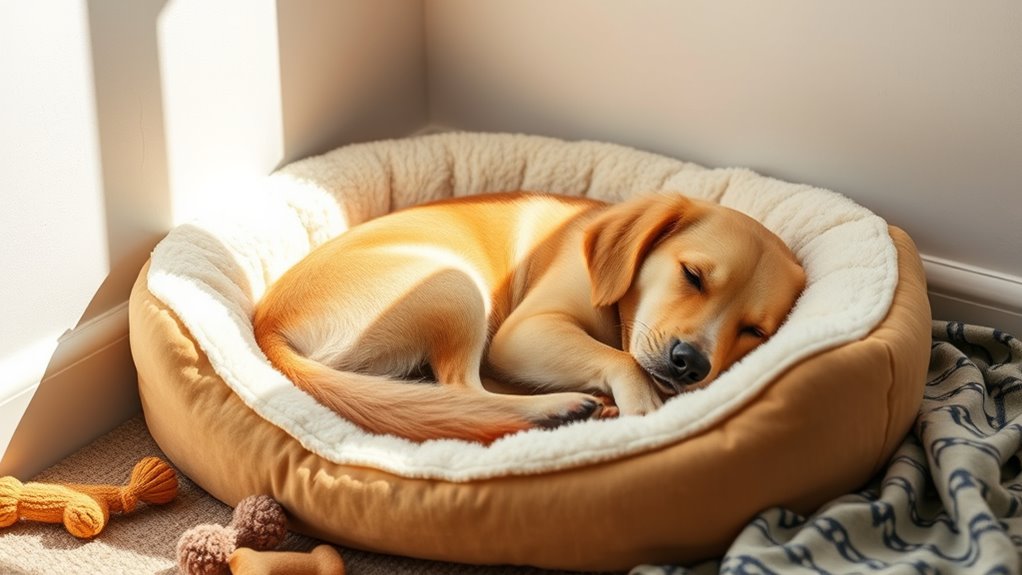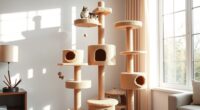To choose a comfortable dog bed, consider your dog’s size, sleeping habits, and preferred position. Pick a bed made from durable, breathable materials that support joint health and suit their activity level. Confirm the bed is easy to clean and matches your home’s decor. Watch for signs your dog might need a new one, like discomfort or changes in sleep. Keep exploring for more tips to find the perfect cozy spot for your pup.
Key Takeaways
- Assess your dog’s size, sleeping position, and activity level to select an appropriately sized and shaped bed.
- Choose breathable, durable, and easy-to-clean materials that support comfort and longevity.
- Monitor your dog’s behavior and signs of discomfort to ensure the bed meets their needs.
- Consider orthopedic options with proper support to promote healthy sleep and joint health.
- Match the bed style and design to your home decor while ensuring it provides a cozy, secure resting space.
Assessing Your Dog’s Size and Sleeping Habits
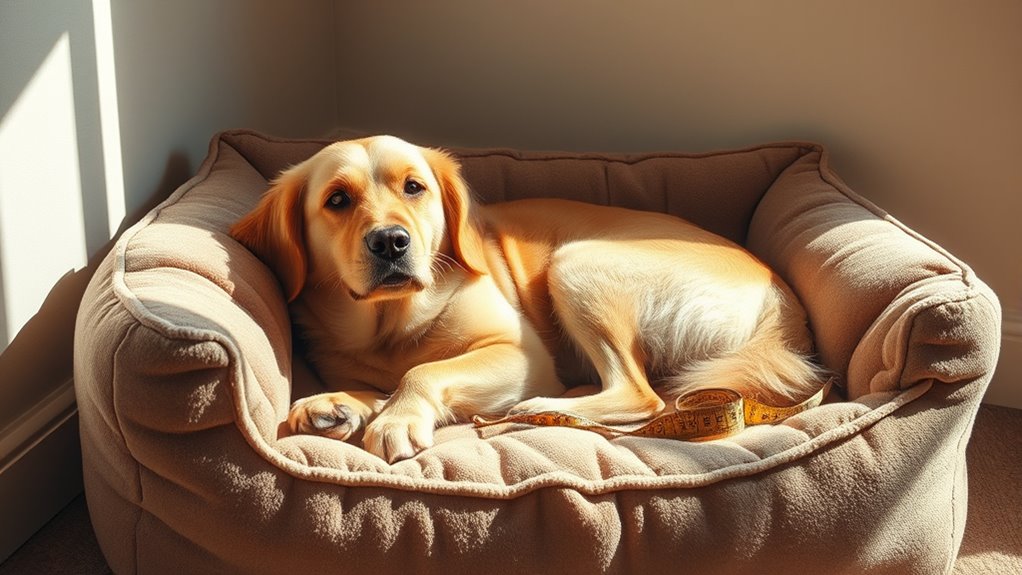
To choose the right dog bed, you first need to contemplate your dog’s size and sleeping habits. Knowing whether your dog prefers stretching out or curling up helps determine the ideal bed size and shape. Consider where you’ll place the bed; a quiet, draft-free spot works best for restful sleep, so plan your dog bed placement accordingly. Think about your dog’s activity level—active dogs may need a more supportive, cushioned bedding accessory to handle movement. Larger dogs require more space, while smaller breeds might prefer cozy, enclosed beds. Observing your dog’s bedtime routines will guide you in selecting a bed that suits their comfort needs. Additionally, understanding your dog’s preferred sleeping position can help you choose a bed that provides the appropriate support and comfort. By paying attention to these factors, you ensure your furry friend gets proper rest and support every night.
Selecting the Right Material for Comfort and Durability
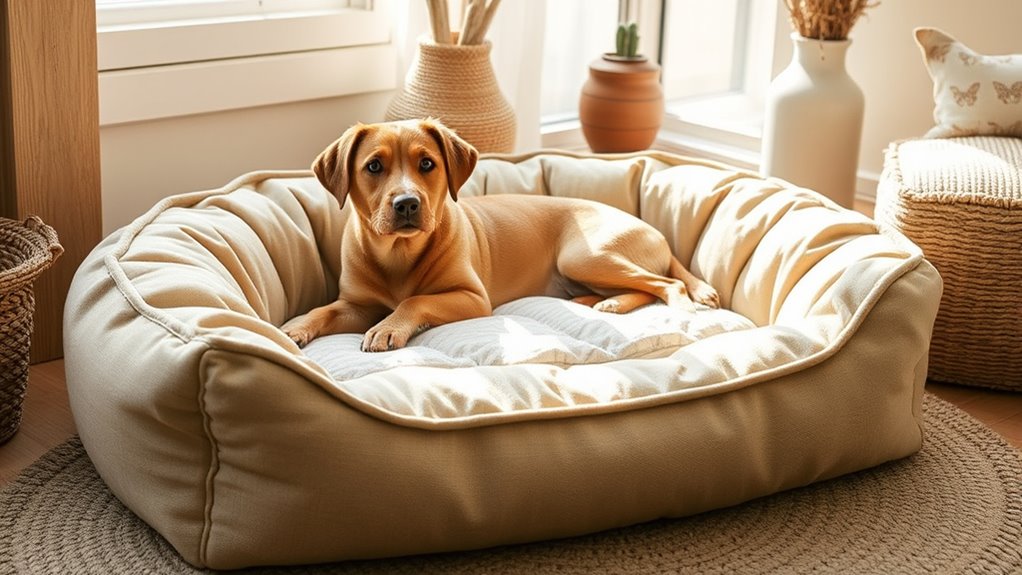
Choosing the right material for your dog’s bed is essential for both comfort and durability. You want a fabric that offers breathability, helping to regulate your dog’s temperature and prevent overheating. Look for materials like cotton blends or breathable mesh that allow air circulation. At the same time, prioritize material durability, especially if your dog is active or tends to chew. Strong fabrics like denim, canvas, or reinforced polyester can withstand wear and tear over time. Avoid cheap or fragile materials that may tear or degrade quickly. Selecting a bed with the right combination of breathable fabric and sturdy construction guarantees your dog stays comfortable and the bed lasts longer, saving you money and hassle in the long run. Additionally, choosing materials that are easy to clean can help maintain hygiene and prolong the lifespan of the bed. Incorporating durable fabrics ensures the bed remains in good condition even with frequent use. Being aware of material quality can help you make better choices for long-term satisfaction. Furthermore, opting for breathable fabrics can also prevent your dog from overheating during warmer months.
Considering Support and Orthopedic Features
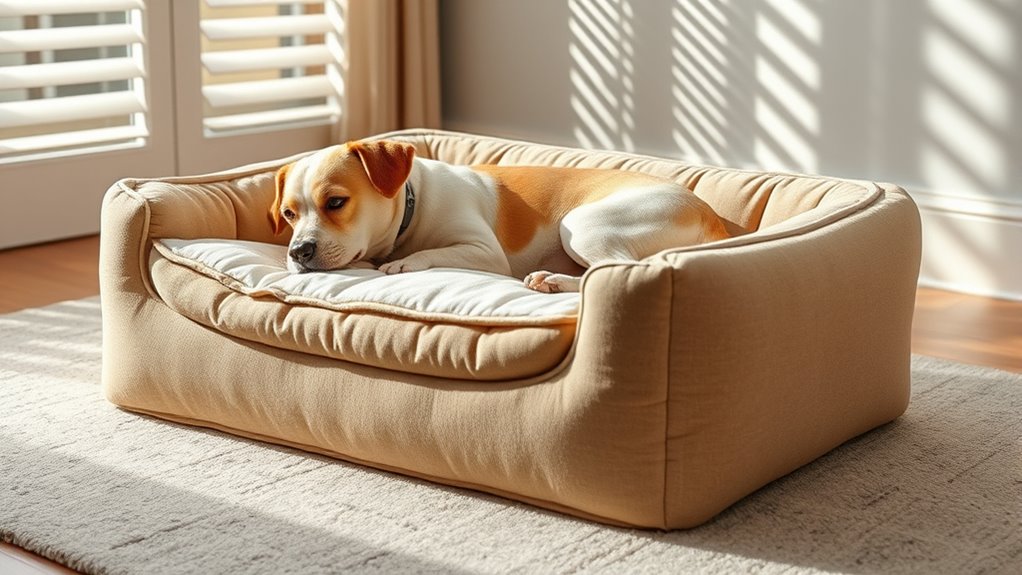
Since dogs age or develop joint issues over time, prioritizing support and orthopedic features in their bed can make a significant difference in their comfort and mobility. Look for beds with memory foam, as it contours to your dog’s body, providing personalized support. Orthopedic support helps reduce pressure on joints, easing discomfort and promoting better rest. These beds are especially beneficial for senior dogs or those with arthritis. Ascertain the bed has enough thickness and firmness to offer proper alignment, but also remains soft enough for relaxation. Additionally, choosing a specialized mattress designed for canine orthopedic needs can further enhance support and durability. Incorporating positive thinking principles into your approach can also help improve your pet’s well-being and your own caregiving experience. Moreover, selecting a proper firmness ensures your dog maintains proper spinal alignment for healthier joints. By choosing a bed with quality orthopedic support and memory foam, you help your dog enjoy restful sleep and maintain mobility longer.
Picking the Appropriate Bed Shape and Style

Once you’ve prioritized support and orthopedic features, selecting the right bed shape and style can further enhance your dog’s comfort. Consider your dog’s sleeping habits and your home’s design when choosing a shape. For example, a bolster bed provides a sense of security, while a flat mattress offers simplicity. Incorporating diverse designs helps match your pet’s needs with your home decor, ensuring both comfort and aesthetic appeal. Matching home decor is key, so opt for styles that blend seamlessly with your space. Incorporating dog names into your choice ensures your pet’s well-being while maintaining aesthetic appeal.
Ensuring Proper Bed Size for Maximum Comfort
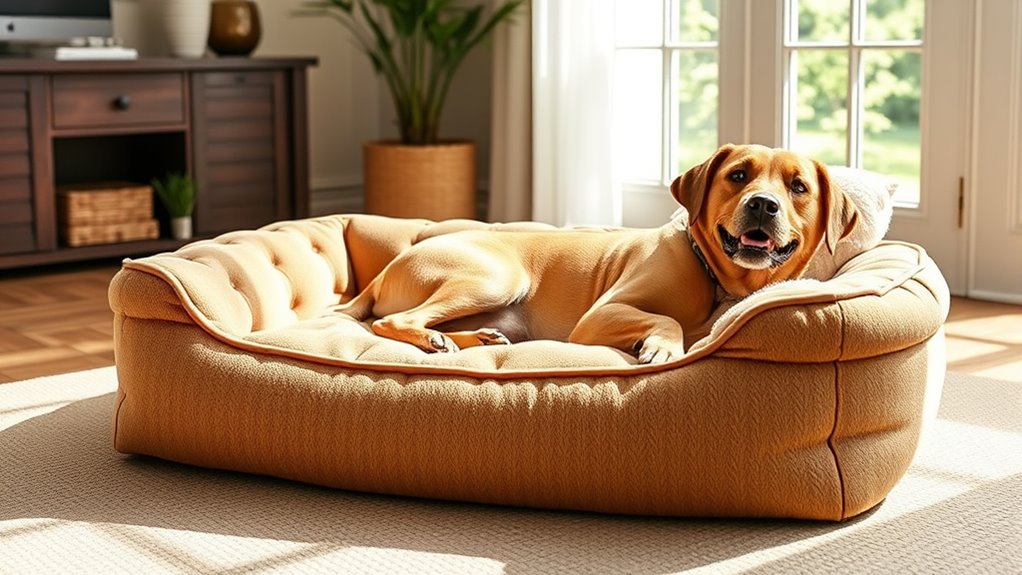
Selecting the right bed size is essential to guarantee your dog sleeps comfortably and maintains good posture. To achieve this, measure your dog from nose to tail and add a few inches for movement and stretching. A bed that’s too small can restrict your dog’s comfort level and cause discomfort, while one that’s too large might make your pet feel insecure or unsupported. Consider your dog’s sleeping position—some prefer to curl up, while others stretch out fully. Make certain the bed offers enough space for their typical sleeping style. Remember, the proper bed size supports good joint health and helps your dog rest peacefully. By choosing a bed that fits well, you boost their comfort level and provide a cozy, supportive spot they’ll love.
Maintaining a Clean and Hygienic Bed Environment
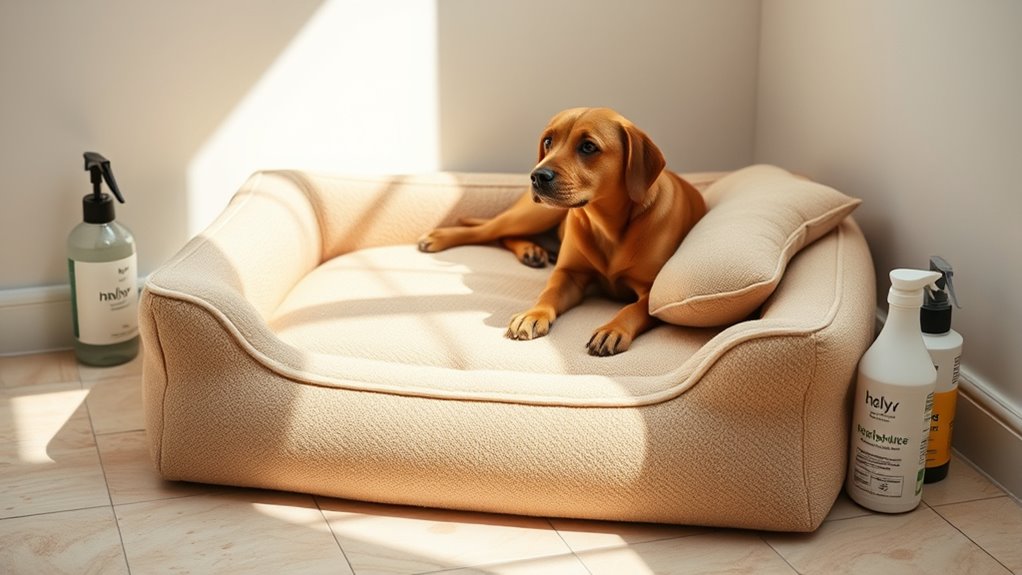
To keep your dog’s bed fresh and safe, establishing a regular washing routine is vital. Use gentle, pet-safe cleaning products to remove dirt, hair, and odors effectively. Staying consistent guarantees a hygienic environment that benefits your dog’s health and comfort. Incorporating effective cleaning routines and essential oils for hygiene into your cleaning routine can further help maintain a fresh and antimicrobial environment. Being aware of cookie categories and managing your consent preferences also ensures a safer browsing experience while researching the best cleaning methods. Regular vacuuming of the bed using a vacuum cleaner with appropriate filtration systems can also help remove allergens and dust, extending the bed’s lifespan.
Regular Washing Schedule
Regularly washing your dog’s bed is essential for keeping it clean and hygienic. A fresh bed not only promotes your dog’s health but also enhances its aesthetics, making your space more inviting. Establish a washing schedule—weekly for active dogs or bi-weekly for less active ones—to prevent dirt buildup. When you wash the bed, you can also explore bed customization options, like removable covers or washable liners, to simplify maintenance. Consistent cleaning keeps odors at bay and creates a cozy environment your dog will love. Maintaining trust in your routines can also reassure your pet and strengthen your bond. Additionally, adhering to proper cleaning and maintenance guidelines ensures the longevity of the bed and keeps it safe for your furry friend. Regular cleaning contributes to hygienic living spaces and supports overall pet health. Incorporating self-watering plant pots as a metaphor, regularly cleaning your dog’s bed helps maintain a healthy environment that supports your pet’s well-being.
Use Safe Cleaning Products
Using safe cleaning products is essential for keeping your dog’s bed hygienic without exposing your pet to harmful chemicals. Opt for natural cleaning methods and non toxic disinfectants to guarantee safety. Regularly wash the bed with gentle, eco-friendly detergents that don’t contain harsh chemicals. For added protection, use non toxic disinfectants to eliminate germs and bacteria without risking irritation or poisoning. Avoid bleach and synthetic cleaners, which can be irritating or toxic to dogs. Instead, choose natural alternatives like vinegar, baking soda, or specially formulated non toxic disinfectants. These options effectively clean and disinfect while maintaining a safe environment for your pet. Incorporating proper cleaning techniques helps ensure your dog’s bed remains free of harmful residues. Additionally, selecting air purifiers with HEPA filters can reduce airborne allergens and odors, further contributing to a healthier indoor environment for your dog. Regular cleaning routines and dust removal also play a crucial role in maintaining a hygienic sleeping area. Ensuring that your cleaning methods are based on evidence-based practices can enhance the safety and effectiveness of your routine. By prioritizing natural cleaning, you help keep your dog’s bed fresh, safe, and comfortable for your furry friend.
Recognizing Signs That Your Dog Needs a New Bed
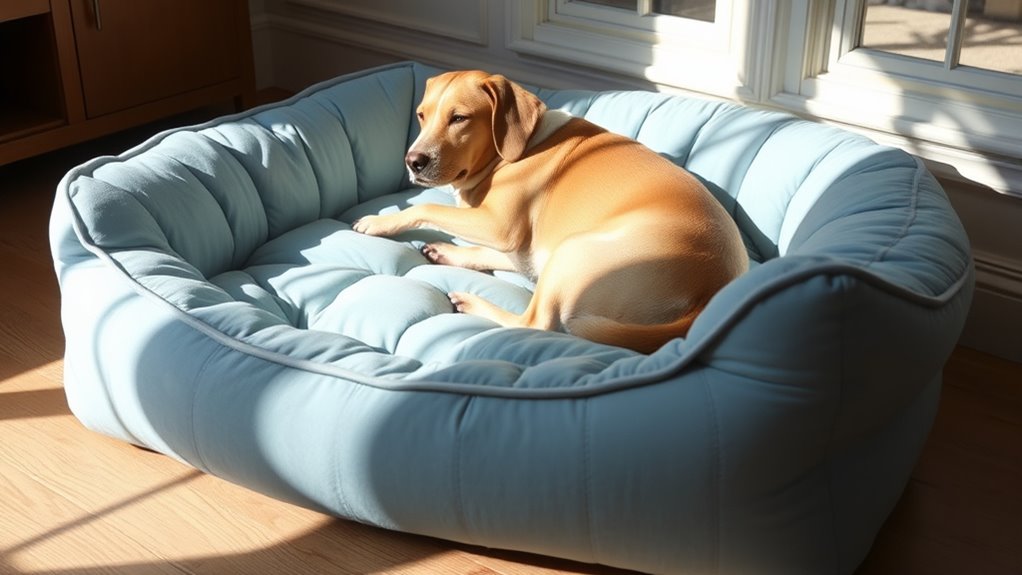
You’ll notice if your dog’s sleeping habits change, like staying awake longer or refusing their bed altogether. Signs of discomfort, such as whining or shifting frequently, also indicate it might be time for a new bed. Paying attention to these cues helps make certain your dog stays comfortable and well-rested.
Changes in Sleeping Habits
If your dog’s sleeping habits suddenly change, it could be a sign that their current bed no longer satisfies their needs. You might notice sleep pattern changes, such as waking up frequently or difficulty settling down. They may also alter their bedtime routines, avoiding the bed altogether or switching spots often. These shifts can indicate discomfort or that the bed no longer provides proper support. Pay attention to how your dog behaves during rest; if they seem restless or less relaxed, it’s time to reassess their sleeping environment. A comfortable, supportive bed helps maintain healthy sleep patterns and keeps your dog happy. Recognizing these signs early ensures you can choose a new bed that better suits their current needs. Additionally, nutritional well-being is essential for overall health, including restful sleep. Incorporating proper rest and recovery strategies, like providing a cozy and supportive bed, can significantly improve your dog’s comfort and health.
Signs of Discomfort
When your dog’s sleeping habits change unexpectedly, it’s a clear sign that their current bed may no longer meet their comfort needs. They might scratch or paw at the bed, indicating discomfort or restlessness. If your dog starts avoiding their usual spot or shows signs of stiffness and difficulty getting comfortable, it’s time to contemplate a new bed. Pay attention to their body language—licking, whining, or shifting frequently can signal pain or discomfort. Also, assess the dog bed aesthetics and bedding color options; if the bed looks worn or mismatched with your decor, it might be a cue to upgrade. A comfortable, supportive bed tailored to your dog’s preferences can help improve their sleep quality and overall well-being.
Frequently Asked Questions
How Often Should I Replace My Dog’S Bed?
You should replace your dog’s bed when it shows signs of wear, like torn fabric or persistent odors. The bed material can deteriorate over time, reducing comfort and hygiene. Also, guarantee the bed size still fits your dog’s needs; as they grow or age, they might need a different size for proper support. Regularly inspect the bed and replace it as needed to keep your dog cozy and healthy.
Can a Dog Bed Help With Joint Pain?
Imagine a soft haven that cradles your dog’s joints like a gentle embrace. Yes, a dog bed with orthopedic support can help ease joint pain, especially if it features quality bed materials designed for comfort and stability. You give your pup relief from ache and stiffness, making each nap a soothing retreat. Prioritize supportive, plush beds to improve mobility and reduce discomfort, transforming rest into healing.
Are Waterproof Beds Necessary for Outdoor Dogs?
Waterproof beds aren’t always necessary for outdoor dogs, but they do offer advantages. If your dog spends a lot of time outside, a bed with waterproof materials can guard against moisture, mud, and accidents. This enhances outdoor durability and keeps your pet comfortable and dry. Consider your dog’s environment; if it’s wet or muddy often, a waterproof bed is a smart investment to ensure they stay cozy and protected.
What Is the Best Bed for a Puppy?
Ever wonder what makes the perfect bed for your puppy? You should consider material choices and bed size to guarantee comfort and support. Opt for soft, durable fabrics that are easy to clean, and choose a size that allows your puppy to stretch comfortably without being too large. Wouldn’t you want a cozy, safe space that grows with your puppy? Picking the right bed now sets the foundation for their comfort and happiness.
How Do I Introduce a New Bed to My Dog?
When introducing a new dog bed, start by choosing the right bed size that suits your dog’s comfort. Place the bed in a quiet, familiar spot with good dog bed placement to encourage use. Gently guide your dog to the new bed, using treats or praise to make it inviting. Be patient, allowing your dog to explore at their own pace, and soon they’ll see it as a cozy, safe space.
Conclusion
Choosing the right dog bed wraps your furry friend in a cozy haven, like a soft cloud inviting them to rest peacefully. When you pick the perfect size, material, and support, you create a sanctuary where they can curl up comfortably, dream, and recharge. Keep it clean and watch them settle in happily, knowing you’ve crafted their favorite spot to relax and feel safe. A comfortable bed truly turns everyday naps into blissful escapes.
